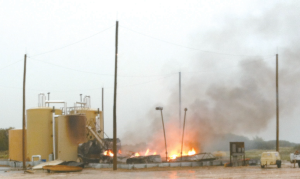Think your facilities are protected from lightning and static? Even the best intentions require regular QA and QC
“Once is not enough”, says Lightning Master Corporation® (LMC) Founder and CEO Bruce Kaiser. Having Lightning Master install lightning and static prevention equipment around tanks and other oilfield facilities is a great start. But it’s important to make sure your protection is maintained.

Lightning ignites storage tanks
What could go wrong, you ask? Here is a short list.
Maintenance and cleaning crews. Sometimes workers must disconnect or move lightning or static prevention equipment in order to repair something nearby or to complete a site cleanup. Do they remember to reconnect? Do they know how to reconnect? No matter how good your prevention equipment is, if it’s disconnected or out of place when it’s needed you could risk a fire or explosion.
Plant expansion. So you made sure all the tanks you had in place last year were fully protected from static and lightning. That’s a great start. But since then you’ve added one tank and had to move another. Did you add protection to the new tank? Did anyone make sure the tank that was moved was still connected?
Regular quality assurance (QA) and quality control (QC) involving inspections and updates are essential. It is nice to know that Lightning Master® provides all those services so you can focus on your main business.
Here is how their system works: As a follow-up to their initial installation they offer six-month, 12-month or 2 year maintenance QC programs. Each program involves a detailed site review, inspection of their air terminals, bonding/grounding, and corrosion evaluation. The LMC Inspector will use the original installation photos and completion forms to note any changes, add-ons, or work that might have affected the integrity of the lightning protection system. The Inspector will:
- Check termination points to ground looking for corrosion and a tight bond of the cable and components to ground.
- Check connections on isolated steel ensuring that the bond and cable still meet LMC standards.
- Inspect air terminals and hardware, noting corrosion, if any, quality of bond (connections), broken and missing parts, and electrode condition.
- Inspect In-Tank Static Drain (ITSD) and hardware in all tanks where they are installed noting corrosion, if any, quality of bond (connections) and electrode condition.
You will receive a detailed report of the inspection of LMC’s equipment noting their findings and recommendations. The report will include a copy of the installation completion form and photography from the initial installation in addition to the QC inspection. If there are any changes to the facility from the time of the initial installation to the date of the QC report you will be notified and the details documented in the report. LMC will include a written proposal for additional work recommended to bring the facility up to NFPA 780 standards and to maintain the operational integrity of the LMC system. LMC’s systems are designed to be low-maintenance, but not maintenance free, so they recommend periodic inspections. And if you purchase a QA/QC program before the end of 2016 you’ll save 30 percent.
To install or inspect static control systems call Lightning Master this week.
Contact the experts at Lightning Master at 800-749-6800 or email them at [email protected].

